Themed collection Nano- and Molecular Engineering of Photosensitisers

Introduction to the themed issue ‘Nano- and Molecular Engineering of Photosensitisers’
Welcome to this Photochemical & Photobiological Sciences themed issue entitled: ‘Nano- and Molecular Engineering of Photosensitisers’.

Photochem. Photobiol. Sci., 2018,17, 1488-1489
https://doi.org/10.1039/C8PP90047G
Trends and targets in antiviral phototherapy
With its principles discovered more than a hundred years ago the photodynamic inactivation of viruses is now routinely employed in the decontamination of blood products but also investigated for HPV treatment and water disinfection and food safety.
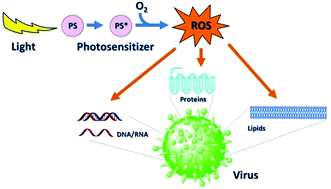
Photochem. Photobiol. Sci., 2019,18, 2565-2612
https://doi.org/10.1039/C9PP00211A
Chemical approaches for the enhancement of 5-aminolevulinic acid-based photodynamic therapy and photodiagnosis
The development of photodynamic therapy and photodiagnosis with 5-aminolevulinic acid presents a number of challenges that can be addressed by applying chemical insight and a range of novel prodrug strategies.
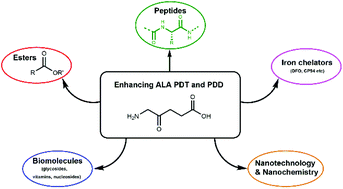
Photochem. Photobiol. Sci., 2018,17, 1553-1572
https://doi.org/10.1039/C8PP00362A
Wastewater chemical contaminants: remediation by advanced oxidation processes
A review on novel approaches for wastewater remediation based on advanced oxidation processes (AOPs), including the photodynamic approach mediated by tetrapyrrolic derivatives.

Photochem. Photobiol. Sci., 2018,17, 1573-1598
https://doi.org/10.1039/C8PP00249E
Photosensitiser-gold nanoparticle conjugates for photodynamic therapy of cancer
A review describing the state-of-the-art of the functionalisation of gold nanoparticles with photosensitisers and targeting ligands for photodynamic cancer therapy.
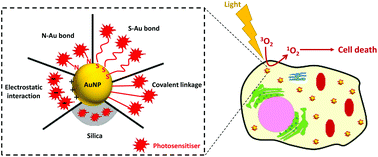
Photochem. Photobiol. Sci., 2018,17, 1534-1552
https://doi.org/10.1039/C8PP00271A
Some activities of PorphyChem illustrated by the applications of porphyrinoids in PDT, PIT and PDI
Photodynamic therapy is an innovative approach to treat diverse cancers and diseases that involves the use of photosensitizing agents along with light of an appropriate wavelength to generate cytotoxic reactive oxygen species.
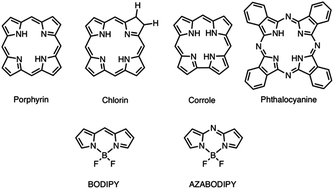
Photochem. Photobiol. Sci., 2018,17, 1675-1690
https://doi.org/10.1039/C8PP00222C
Combination of PDT photosensitizers with NO photodononors
The appropriate assembly of PDT photosensitizers and NO photodonors may open up intriguing avenues towards new and still underexplored multimodal therapies not based on “conventional” drugs but entirely controlled by light stimuli.
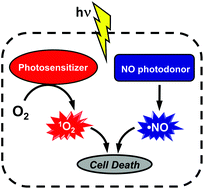
Photochem. Photobiol. Sci., 2018,17, 1709-1727
https://doi.org/10.1039/C8PP00272J
Fullerenes as photosensitizers in photodynamic therapy: pros and cons
Fullerenes can act as photosensitizers for photodynamic therapy. Advantages include chemical and photochemical versatility, nanotechnology potential, resistance to photobleaching. Disadvantages include short wavelength absorption, pronounced aggregate and high molecular weight.
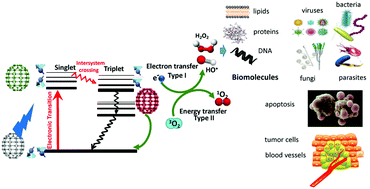
Photochem. Photobiol. Sci., 2018,17, 1515-1533
https://doi.org/10.1039/C8PP00195B
Mesoporous silica nanoparticles in recent photodynamic therapy applications
In this review, the use of mesoporous silica nanoparticles for photodynamic therapy (PDT) applications is described for the year 2017.
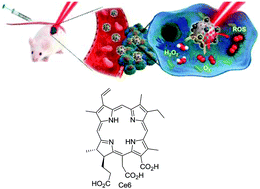
Photochem. Photobiol. Sci., 2018,17, 1651-1674
https://doi.org/10.1039/C8PP00143J
Using X-rays in photodynamic therapy: an overview
Photodynamic therapy is a therapeutic option to treat cancer and other diseases.

Photochem. Photobiol. Sci., 2018,17, 1612-1650
https://doi.org/10.1039/C8PP00112J
A glycoporphyrin story: from chemistry to PDT treatment of cancer mouse models
Glycoporphyrin: from bench to preclinical studies on PDX xenografted on mice.
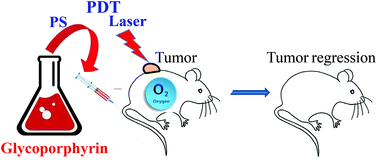
Photochem. Photobiol. Sci., 2018,17, 1599-1611
https://doi.org/10.1039/C8PP00123E
Recent strategies to improve boron dipyrromethene (BODIPY) for photodynamic cancer therapy: an updated review
BODIPYs are photosensitizers activatable by light to generate highly reactive singlet oxygen (1O2) from molecular oxygen, leading to tissue damage in the photoirradiated region.

Photochem. Photobiol. Sci., 2018,17, 1691-1708
https://doi.org/10.1039/C8PP00113H
The good, the bad, and the ugly – controlling singlet oxygen through design of photosensitizers and delivery systems for photodynamic therapy
To afford effective photosensitizers and delivery systems for photodynamic therapy their design phase must consider all aspects of singlet oxygen. This perspective highlights that progression of this field is dependent on the control and modulation of its star, singlet oxygen.
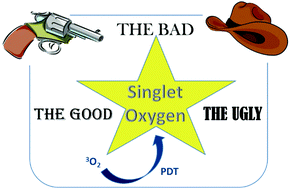
Photochem. Photobiol. Sci., 2018,17, 1490-1514
https://doi.org/10.1039/C8PP00008E
Cyclopeptidic photosensitizer prodrugs as proteolytically triggered drug delivery systems of pheophorbide A: part II – co-loading of pheophorbide A and black hole quencher
Co-loading of pheophorbide A and black hole quencher moieties onto cyclopeptidic templates led to photosensitizer prodrugs with ultra-high initial quenching.
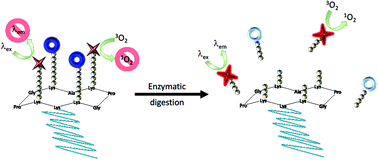
Photochem. Photobiol. Sci., 2018,17, 1739-1748
https://doi.org/10.1039/C8PP00318A
Cyclopeptidic photosensitizer prodrugs as proteolytically triggered drug delivery systems of pheophorbide A: part I – self-quenched prodrugs
RAFTs bearing multiple copies of pheophorbide A allow perfectly defined photosensitizer prodrugs.
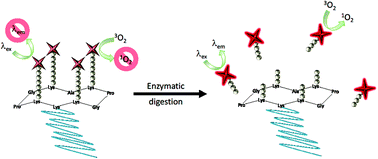
Photochem. Photobiol. Sci., 2018,17, 1728-1738
https://doi.org/10.1039/C8PP00317C
Investigation of the factors affecting the photothermal therapy potential of small iron oxide nanoparticles over the 730–840 nm spectral region
Photothermal activity of SPIONs is not dependent on the excitation wavelength, attenuation or laser intensity but to the power.
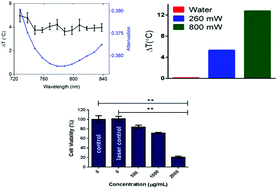
Photochem. Photobiol. Sci., 2018,17, 1787-1793
https://doi.org/10.1039/C8PP00203G
Effect of thiophene substitution on the intersystem crossing of arene photosensitizers
Thiophene substitution gives energy level-matched S1/T2 states and the ISC is enhanced, which was not observed with phenyl substitution.
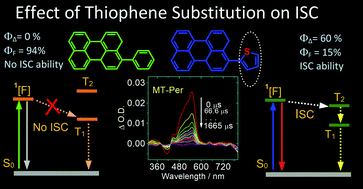
Photochem. Photobiol. Sci., 2018,17, 1794-1803
https://doi.org/10.1039/C8PP00230D
Antibacterial activity of a photosensitive hybrid cellulose fabric
A new photosensitive hybrid cellulose material, synthesized by polymerization of methacrylic acid (MAA) and PpIX, showed photoantibacterial activity against Staphylococcus aureus.
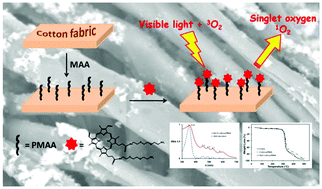
Photochem. Photobiol. Sci., 2018,17, 1780-1786
https://doi.org/10.1039/C8PP00212F
Synthetic, small-molecule photoantimicrobials – a realistic approach
Small molecule cationic photosensitizers based on standard chromophores offer considerable potential in photoantimicrobial development via chromophore elaboration or peripheral functionalisation.
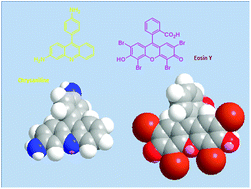
Photochem. Photobiol. Sci., 2018,17, 1767-1779
https://doi.org/10.1039/C8PP00145F
Photodynamic properties of aza-analogues of phthalocyanines
Spectral and photophysical properties and in vitro photodynamic activity of aza-analogues of phthalocyanines are summarized.
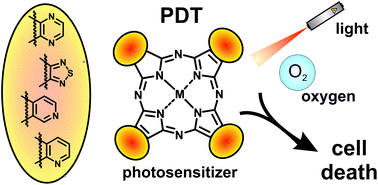
Photochem. Photobiol. Sci., 2018,17, 1749-1766
https://doi.org/10.1039/C8PP00106E
About this collection
Like many English words, photosensitiser arises from Greek roots and literally means something sensitive to light, clearly a very broad definition. In this themed issue of Photochemical & Photobiological Sciences, photosensitiser stands only for systems which generate reactive oxygen species upon appropriate excitation and in suitable conditions. These papers focus on the design, synthesis and evaluation of such photosensitisers.
Photosensitising systems involve an infinite variety of molecular and nano-structures and involve multiple mechanisms of action. They are used in medicine as photodynamic therapy treatment for cancer but also have activity against infections and optical diseases, and are used in the environment for water decontamination, etc. Different excitation modes, ranging from visible light to X-ray, need specific photosensitising structures.
The role of the engineer, often but not always a chemist, is crucial in the development of new photosensitisers. This is highlighted in this issue which is a collection of reviews and research articles from around the world. As for light, the topic has indeed no frontiers!
Fabienne Dumoulin (Guest Editor)